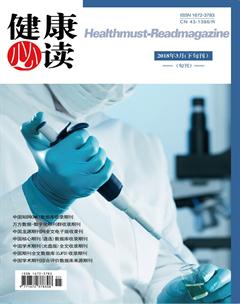母体环境暴露与胎儿先天性心脏病病因的相关性研究
蔡贵榕
【摘要】目的:探讨母体环境暴露与胎儿先天性心脏病(congenital heart disease, CHD)病因的相关性, 对CHD的预防进行临床指导。方法:回顾性分析 2014.11~2017.11来我院就诊的62例先天性心脏病胎儿的母亲为观察组,同期出生的62例健康胎儿的母亲为对照组,通过本院自制的调查问卷,对两组胎儿的母亲家族史、生育年龄、民族、健康状况、孕产史、药物接触史、农药接触史、孕前及孕期环境嘈杂情况、孕期胎儿情况、教育情况、不良生活史、收入情况、工作情况等情况进行调查分析。结果:观察组女性胎儿比例显著高于对照组,差异有统计学意义,P<0. 05 ;观察组母亲的先天性心脏病家族史、生育年龄、健康状况、流产史、药物接触史、农药接触史、噪声、不良妊娠史、胎儿异常、不良生活史、收入等因素与对照组相比,差异有统计学意义,P<0. 05。结论:母体孕前期和孕期的多种环境因素与胎儿先天性性脏病的发生相关,改善母体的健康状况,减少危险因素的暴露,对防控胎儿先天性心脏病的发生具有重要意义。
【关键词】母体;环境因素;胎儿;先天性心脏病;相关性
Relationship between maternal environmental exposure and etiology of fetal congenital heart disease
Abstract Objective: To explore the relationship between maternal environmental exposure and the etiology of fetal congenital heart disease (CHD) and to provide clinical guidance for the prevention of CHD. Methods : The mothers of 62 congenital heart disease fetuses who visited our hospital from 2014.11 to 2017.11 were retrospectively analyzed. The mothers of 62 healthy fetuses born in the same period were the control group, t hrough the self-made questionnaire in our hospital, we analyzed the mother's family history, birth age, ethnicity, health status, mother's history, drug exposure history, history of exposure to pesticides, noisy environment before and during pregnancy, fetus during pregnancy, education situation , Bad life history, income, work conditions and other circumstances for investigation and analysis. Results: The proportion of female fetuses in observation group was significantly higher than that in control group, the difference was statistically significant (P <0.05); compared with the control group, the factors such as family history of congenital heart disease, childbearing age, health status, abortion history, drug exposure history, history of pesticide exposure, noise, adverse pregnancy history, fetal abnormalities, adverse life history, The difference was statistically significant, P <0.05. Conclusion: The maternal preconception and pregnancy multiple environmental factors associated with the occurrence of fetal congenital heart disease, improve the health status of maternal and reduce exposure of risk factors, prevention and control of fetal congenital heart disease is of great significance.
Key words: maternal; environmental factors, fetus, congenital heart disease, relativity
【中圖分类号】 R54l
【文献标识码】 B
【文章编号】 1672-3783(2018)03-03-024-01
先天性心脏病(congenital heart disease, CHD)[1, 2]是临床常见的一种先天性畸形,主要是由于受环境、遗传等因素影响,胎儿心血管在胚胎发育过程中局部解剖结构的异常发育,或胎儿出生后,该自行闭合的通道未闭合而发生[3, 4]。近年来,随着社会的发展,环境的污染[5, 6],生活压力的增加[7],先天性心脏病的发病率逐渐升高[8],严重影响了患儿的生活质量,也给家庭和社会带来巨大的经济和心理负担,因此,如何有效防治先天性心脏的发生,成为全民关注的重点[9]。目前研究普遍认为,先天性心脏病的发生和遗传因素[10]、母体因素[11]、环境因素、表观遗传因素等相关,寻找先天性心脏病的相关危险因素,并进行积极、有效地防治,已成为预防先天性心脏病发病的一级课题。本研究旨在探讨母体环境暴露与胎儿先天性心脏病病因的相关性, 以期对先天性心脏病的预防进行临床指导。
1资料和方法
1.1一般资料选取2014.11~2017.11来我院就诊的62例先天性心脏病胎儿的母亲为观察组,同期出生的62 例健康胎儿的母亲为对照组。所有观察组胎儿均经过彩色多普勒或手术等确证为先天性心脏病,具体分类见表1。排除标准:①心肌炎患儿;②伴发其他先天性疾病患儿;③严重心、肝、肾功能障碍患儿;④母亲无法配合完成调查问卷者。所有入选者都了解此项研究,并签署知情同意书。
1.2方法采用本院自制的调查问卷,对两组对象进行面对面的调查,调查内容主要包括母亲一般情况(姓名、民族、生育时年龄、既往病史,吸烟和饮酒等不良生活史、妊娠史、收入、职业、文化程度等)和可疑危险因素暴露情况(药物接触史、农药接触史、孕前及孕期环境嘈杂情况等)。由本项目组成员对调查表的内容进行审核并录入。
1.3统计学处理采用SPSS19.0统计学软件进行分析。计量资料用均值±标准差(x±s)来表示,组间比较采用 t 检验;计数资料用百分比(%)来表示,组间比较采用x2检验。均采用双侧检验,以 P< 0. 05 为差异有统计学意义。
2结果
观察组女性胎儿比例显著高于对照组,差异有统计学意义,P<0. 05;观察组母亲的先天性心脏病家族史、生育年龄、健康状况、流产史、药物接触史、农药接触史、孕前及孕期环境嘈杂情况、不良妊娠史、胎儿异常、不良生活史、收入因素与对照比相比有显著差异 P<0. 05,结果见表2。
3讨论
先天性心脏病一种常见的出生缺陷[12, 13],嚴重威胁了患儿的生命健康,近年来随着社会的发展,环境因素的污染,备孕妇女生活压力的增加,先天性心脏病胎儿的出生率逐年增高,成为严重影响优生优育的公共卫生难题。但对于先天性心脏病的病因还未明确,目前普遍认为是遗传[10]和环境因素共同作用的结果,妊娠早期(第 3~8 周)是胚胎心脏发育的关键时期[14],此期间若母体受到不良环境因素的刺激,则容易影响胎儿心脏的发育,导致胎儿先天性心脏病的发生[15, 16]。
本研究发现,母体的先天性心脏病家族史、高生育年龄、健康状况差、流产、药物接触史、农药接触史、噪声干扰史、不良妊娠史、胎儿异常、不良生活史、低收入等因素均会导致胎儿先天性心脏病的发病率升高。随着年龄的增高,卵子的质量会逐渐下降,先天性心脏病胎儿的出生率也会升高;自然流产是淘汰先天缺陷胚胎的一种自然规律,因此既往有流产、不良妊娠史会导致胎儿出生缺陷的比例增加;若产妇的身体健康状况较差,也会对胎儿造成影响,增加胎儿畸形的发生,尤其是心血管系统和神经系统的影响最明显[17];孕期的用药或有毒物质接触史,会通过血液循环影响胎儿,导致胎儿的异常发育,使先天性心脏病的发生率增加; 生活环境中的噪音以低频为主,易与人体脏腑产生共振,长期处于噪声干扰的环境下,可损伤孕妇心、肝、肺、肾等重要器官,使孕妇机体各项功能降低,进而影响胎儿各个系统的发育情况,导致先天性心脏病的发病率增加。
综上所述,我们通过分析找出了一些先天性心脏病胎儿发病相关的母体因素,因此,对于计划怀孕的妇女应加强自我保健意识,对可能的危险因素进行积极防范,尽量避免危险因素的暴露,建立良好的生活方式,注重孕前保健。同时,提高产前诊断和保健水平,提高产妇的保健质量,做好一级预防,对防控先天性心脏病胎儿的出生,提高人口质量具有重要意义。
参考文献
[1]Connolly HM. Managing congenital heart disease in the obstetric patient[J]. Semin Perinatol, 2018, 42(1): 39-48.
[2]Ernst MM, Marino BS, Cassedy A, et al. Biopsychosocial Predictors of Quality of Life Outcomes in Pediatric Congenital Heart Disease[J]. Pediatr Cardiol, 2018, 39(1): 79-88.
[3]Chakravarti S,Busovsky-McNeal M. Use of Tolvaptan in a Patient With Palliated Congenital Heart Disease[J]. World J Pediatr Congenit Heart Surg, 2018, 9(1): 114-116.
[4]Bartra S. Transcatheter Pulmonary Valve Replacement in Patients With Congenital Heart Disease[J]. Crit Care Nurse, 2018, 38(1): 30-36.
[5]Vecoli C, Pulignani S, Foffa I, et al. Congenital heart disease: the crossroads of genetics, epigenetics and environment[J]. Curr Genomics, 2014, 15(5): 390-9.
[6]Garg V,Basu M. Beyond genetics: focusing on maternal environment for congenital heart disease prevention[J]. Evid Based Med, 2014, 19(2): e8.
[7]Kako H, Alkhatib O, Krishna SG, et al. Changes in intracuff pressure of a cuffed endotracheal tube during surgery for congenital heart disease using cardiopulmonary bypass[J]. Paediatr Anaesth, 2015, 25(7): 705-10.
[8]VanderPluym CJ, Cedars A, Eghtesady P, et al. Outcomes following implantation of mechanical circulatory support in adults with congenital heart disease: An analysis of the Interagency Registry for Mechanically Assisted Circulatory Support (INTERMACS)[J]. J Heart Lung Transplant, 2018, 37(1): 89-99.
[9]Muller J, Ewert P,Hager A. Number of thoracotomies predicts impairment in lung function and exercise capacity in patients with congenital heart disease[J]. J Cardiol, 2018, 71(1): 88-92.
[10]Blue GM, Kirk EP, Sholler GF, et al. Congenital heart disease: current knowledge about causes and inheritance[J]. Med J Aust, 2012, 197(3): 155-9.
[11]Begum S,Dey SK. Clinical profile and pattern of congenital heart disease in infants of diabetic mother and infants of non-diabetic mother at a tertiary care hospital[J]. J Neonatal Perinatal Med, 2017, 10(4): 403-408.
[12]Huang HR, Chen CW, Chen CM, et al. A positive perspective of knowledge, attitude, and practices for health-promoting behaviors of adolescents with congenital heart disease[J]. Eur J Cardiovasc Nurs, 2018, 17(3): 217-225.
[13]Koenraadt WMC, Bartelings MM, Bokenkamp R, et al. Coronary anatomy in children with bicuspid aortic valves and associated congenital heart disease[J]. Heart, 2018, 104(5): 385-393.
[14]Jaffe AS. Improving the Specificity of Cardiac Biomarkers-The Early Development of Cardiac Troponin I (cTnI) Assays[J]. Clin Chem, 2018, 64(3): 609-610.
[15]Stroud MJ, Fang X, Zhang J, et al. Luma is not essential for murine cardiac development and function[J]. Cardiovasc Res, 2018, 114(3): 378-388.
[16]Motohashi Y, Shimada R, Sasaki T, et al. Development of a simple device enabling percutaneous flow regulation for a small vascular graft for a Blalock-Taussig shunt capable of flow regulation: complete translation of a review article originally published in Pediatric Cardiology and Cardiac Surgery (154-159, 2016: vol. 32)[J]. Gen Thorac Cardiovasc Surg, 2018, 66(3): 145-149.
[17]Peyvandi S, Kim H, Lau J, et al. The association between cardiac physiology, acquired brain injury, and postnatal brain growth in critical congenital heart disease[J]. J Thorac Cardiovasc Surg, 2018, 155(1): 291-300 e3.

